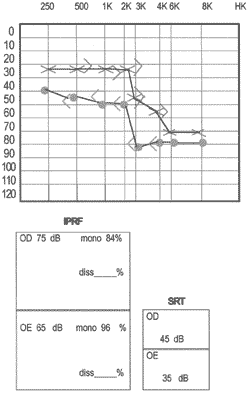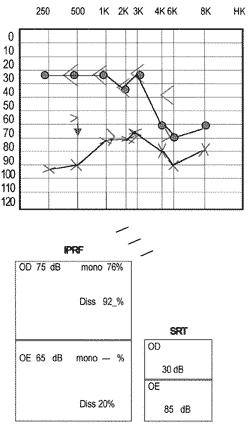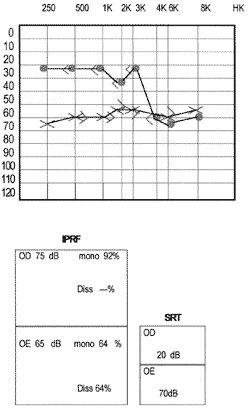

Year: 2002 Vol. 68 Ed. 3 - (21º)
Relato de Caso
Pages: 431 to 434
Differential diagnosis between Cogan's syndrome
Author(s):
Mariana Dantas Aumond (1),
Fernando Danelon Leonhardt (2),
Carlos Eduardo Cesário de Abreu (3),
Norma de Oliveira Penido (4)
Keywords: Cogan's syndrome, vestibular neuronitis, vertigo
Abstract:
Cogan's syndrome is a disease of difficult diagnosis as there is no specific laboratorial exam and the same occurs with Vestibular Neurinitis. The clinical features of Cogan's syndrome are nonsyphilitic interstitial keratitis and vestibuloauditory dysfunction. Evidences of systemic vasculitis are found in 50% of the patients. The atypical forms of Cogan's syndrome array more severe inflammatory ocular disease. The clinical features of the Vestibular Neuronitis are acute episodes of vertigo that doesn't respond to clinical treatment. We exemplify these diagnostical difficulties with the case study of a patient who initiated a state of acute episodes of vertigo associated with fever and unilateral ocular pain. The patient was hospitalized, and initiated therapy for vestibular symptoms, not responding to medications. A week later, the patient evoluted to an ocular disease characterized by anterior sclerouveitis. With fifteen days of evolution, the patient presented a state of rapidly progressive hearing loss. The otoneurological exam showed unilateral diminished caloric response. Magnetic resonance imaging showed signs of microvasculitis in the central nervous system, being diagnosed Cogan's syndrome. Therapy was initiated with oral prednisone and cyclophosphamide, with total improvement of vertigo, dizziness and eye symptoms and partial improvement of sensorineural hearing loss.
![]()
Introduction
Cogan's syndrome was first described by Morgan and Baungartner in 1934 as an auditory-vestibular dysfunction associated to non-syphilitic interstitial keratitis; it was later classified as a clinical entity by Cogan in 19458,4. Cochleo-vestibular symptoms start suddenly with vertigo, tinnitus, nausea, vomiting, ataxia and sensorineural hearing loss, most of the times bilateral10. Atypical forms of the disease involve other ocular inflammatory manifestations, such as scleritis, episcleritis, uveitis, iritis and conjunctivitis, normally associated to systemic rheumatic manifestations and vestibular neuronitis 5.
Vestibular neuronitis was described as a clinical entity more than 40 years ago, also called epidemic vertigo, epidemic neural labyrinthitis, and vestibular paralysis. These terms reflect acute vestibular disorder, normally unilateral, which lasts for days to weeks, preceded by upper airway viral infection and no association with hearing loss7.
We report a clinical case to exemplify Cogan's syndrome that first manifested with disabling vertigo and atypical ocular manifestation, discussing clinical findings, complementary tests, differential diagnosis and treatment.
CASE REPORT
O.M., 63 years old, Caucasian male, born and living in Dracena/SP, pharmacist, reporting history of left eye itching for 15 days, after contact with cleaning product, associated to symptoms of upper airway infections. Seven days before he had manifested sudden loss of balance, vertigo, nausea, vomiting, tinnitus and daily night fever. He did not report hearing loss.
At ENT physical examination, the patient presented closed eye imbalance to the left and horizontal-rotation nystagmus to the right. Initial ophthalmic examination revealed at biomicroscopy significant conjunctival hyperemia and punctata keratitis on the right, and funduscopy with no signs of vasculitis (DH: superficial keratitis medicamentosa).
Initial audiometry (Figure 1) showed bilateral and symmetrical sensorineural hearing loss with mild to moderate loss and one-syllable word discrimination of 84% on the right and 96% on the left. Otoneurologic examination detected hyporeflex on the left.
Initial laboratory tests showed increased hemosedimentation rate (HSR: 110mm/h).
We started management with anti-vertigo drugs and corticoid prednisone 1mg/Kg/day. After one week, the patient reported progressive hearing loss on the left and worsening of ocular and vertigo manifestations. A new ophthalmologic examination with biomicroscopy showed superficial and profound conjunctival hyperemia with anterior chamber reaction and positive pheniledrine test (DH: anterior non-granulomatous sclerouveitis). New audiometry showed bilateral and asymmetrical sensorineural hearing loss, mild to moderate on the right and severe on the left, with one-syllable word discrimination of 76% on the right and 20% on the left (Figure 2). Head magnetic resonance imaging (MRI) was compatible with small vessel vasculitis. Diagnostic hypothesis of Cogan's syndrome was made and we started pulse therapy with solumedrol 1g IV for 3 days and monthly pulse with 1g IV cyclophosphamide, with improvement of clinical, vertigo and ophthalmologic pictures.
Serology for syphilis, rubella, Lyme disease and rheumatology tests were negative. Doppler electrocardiogram showed slight enlargement of left atrium, aortic insufficiency and minimal tricuspid. We performed monthly audiometry and detected progressive improvement of hearing thresholds and vocal discrimination. Audiometry after 3 months of treatment showed sensorineural hearing loss with mild loss on the right and moderate on the left, with one- syllable word discrimination of 92% on the right and 64% on the left (Figure 3).
Figure 1.
Figure 2.
Figure 3.
Discussion
Cogan's syndrome is a rare disease that normally affects young Caucasian patients, with no gender predominance. Etiology is a hypersensitivity response to one or more infectious agents, associated to vasculitis. Some authors believe that B. burgdorferi (Lyme's disease etiological agent) and some species of Chlamydia are the main causing agents, but there is no conclusive evidence2, 3, 11. Lymphocytarian transformation has been reported in the exposure of patient's lymphocytes to corneal antigens, scleroproteins and inner ear antigens. These findings can evidence that the disease is an autoimmune organ-specific affection. Other theory describes that an initial non-organ-specific tissue insult (such as vasculitis induced by immune-complexes) would expose the antigens that trigger auto-immune responses. Systemic compromise is seen in 50-75% of the cases3.
The ophthalmic manifestation is characterized by non-syphilitic interstitial keratitis, including pain, ocular hyperemia, photophobia, blurred vision and lachrymation. Other ocular manifestations include uveitis, iritis, episcleritis, and retina vasculitis. Vestibular symptoms have sudden onset and vertigo episodes, tinnitus, imbalance, nausea and sensorineural, usually bilateral, middle and high frequency hearing loss, with compromised speech discrimination. Hearing losses may be fluctuant such as in hydrops and it may progress to profound loss, which is irreversible in most cases.
Other systemic manifestations include fever, headache, muscle-skeletal involvement (myalgia, arthralgia, arthritis), gastrointestinal complaints, cutaneous damage, cardiovascular compromise (aortic insufficiency, cardiomegaly, CHF), genito-urinary abnormalities, splenomegaly, lymphadenopathy, arterial hypertension and eosinophilia 1.
The exclusion diagnosis is based on clinical suspicion since there are no specific laboratory tests. Nonspecific inflammatory test results such of as hemosedimentation rate (HSR) and reactive protein C (RPC) may be increased. Antibody study against inner ear specific antigen by Western-Blott method (anti hsp70-68kD) is negative6. Magnetic resonance imaging can show hypersignal in inner ear structures of T1 after contrast injection (gadolinium).
Cogan's syndrome has as its main differential diagnoses syphilis, viral diseases such as measles, rubella, herpes zoster and Vogt-Koyanagi-Harada disease. Differential diagnosis with syphilis is made by serology; as to viral diseases, differential diagnosis relies on specific manifestations, and in Vogt-Koyanagi-Harada disease there are uveo-meningeal signs, alopecia and vitiligo.
Initial partial manifestations of Cogan's syndrome may take to other differential diagnoses. In the case reported here, the manifestations included vertigo and ocular symptoms without hearing complaints. Initial audiometry revealed symmetrical and bilateral mild to moderate sensorineural hearing loss. Since the patient had no hearing complaint upon arrival, the hearing loss was understood as being previous to the disease. Moreover, the patient manifested ocular exposure to chemicals and disabling vertigo and unilateral hyporeflex in the otoneurologic test, suggesting vestibular neuronitis (VN).
VN has been referred as epidemic vertigo, acute labyrinthitis, vestibular paralysis and vestibular neuropathology, and the term vestibular neuronitis is the most widely accepted one because it suggests the lesion site: vestibular nerve9. These terms reflect acute disorders of the vestibular system lasting from days to weeks, normally preceded by upper airway viral infection, solved after days or months, and most patients present complete recovery in up to 6 months. Some authors reported cases of VN associated to previous infection by B. burgdorferi (etiologic agent of Lyme's disease). Patients present spontaneous nystagmus and horizontal or rotation-horizontal nystagmus to the non-affected site. Hearing is usually not compromised. VN is unilateral but it may occasionally be bilateral as well. Diagnostic criteria include: acute peripheral vestibular disorder without association with hearing loss; incidence peak between 30 and 60 years; single or recurrent episode of prolonged vertigo or ataxia, and reduction of response to caloric test in the affected ear. From the histopathology standpoint, it is described as degeneration of vestibular nerve, especially of the superior branch and of labyrinthic hair cells7.
VN treatment consists of systemic corticoid therapy, similarly to Cogan's syndrome, as oral prednisone at 1 to 2mg/Kg/day dose. If no response is seen with corticoids, it is recommended the use of immunosuppressant drugs, such as cyclophosphamide, metrotrexate or azathioprin.
In the case reported here, we introduced anti-vertigo drugs and systemic corticoid with prednisone 1mg/Kg/day, based on diagnostic suspicion of VN. The patient experienced rapidly progressive bilateral hearing loss, despite the management, and ophthalmic assessment showed anterior non-granulomatous sclerouveitis, confirming the diagnosis of Cogan's syndrome non-responsive to corticoid therapy. We started treatment with monthly pulses of IV cyclophosphamide 1g, with good clinical response, total remission of vertigo and ocular symptoms and improvement of pure tone thresholds and speech discrimination in the audiometry.
closing remarks
Cogan's syndrome does not necessarily manifest all its characteristics at early stages and it may hinder diagnosis, since it is mainly clinical. Therefore, careful follow-up of patients with serial audiometry, multidisciplinary assessment (otorhinolaryngology, ophthalmology, general practice) are essential for diagnosis. Early treatment influences prognosis of clinical picture, especially the auditory one.
References
1. Berrocal GJR et al. Cogan's syndrome: an oculo-audiovestibular disease. Post Grad Med J 1999;75:262-4.
2. Cheson BD, Blooming AZ, Alroy J. Cogan's syndrome: a systemic vasculitis. Am J Med 1976;60:549.
3. Chynn EW, Jakobiec FA. Cogan's syndrome: ophthalmic, audiovestibular, and systemic manifestation and systemic therapy. Int Ophthalmol Clin 1996;36(1):61-72.
4. Cogan DG. Syndrome of non-syphilitic interstitial keratitis and vestibuloauditory symptoms. Arch Ophthalmol 1945;33:144-149.
5. Cote DN et al. Cogan's syndrome manifesting as sudden bilateral deafness: diagnosis and management. South Med J 1993;86:1056-60.
6. Davis LE. In Cummings CW et al. Otolaryngology Head and Neck Surgery. 3rd. ed. Mosby Inc. 1999.
7. Gacek RR, Gacek MR. Vestibular neuronitis. Am J Otol 1999;20(4): 553-554.
8. Morgan RF, Baungartner CJ. Ménière`s disease complicated by recurrent interstitial keratitis: excellent results following cervical ganglionectomy. West J Surg 1934;42:628.
9. Schuknecht HF, Kitamura K. Vestibular neuritis. Ann Otol Rhinol Laryngol 1981;90(Suppl):1.
10. Schuknecht HF, Nadol JB. Temporal bone pathology in a case of Cogan's syndrome. Laryngoscope 1994 Sept;104.
11. St.Clair EW, Maccallum RM. Cogan's syndrome. Curr Opin Rheumatol 1999; 11(1):47-52.
[1] Resident Physician in Otorhinolaryngology, Escola Paulista de Medicina-UNIFESP.
[2] Resident Physician in Otorhinolaryngology, Escola Paulista de Medicina-UNIFESP.
[3] Resident Physician in Otorhinolaryngology, Escola Paulista de Medicina-UNIFESP.
[4] Ph.D. in Medicine, Escola Paulista de Medicina- UNIFESP.
Study presented as a poster at IV Simpósio Internacional de Transplantes e Implantes em Otologia, Simpósio Internacional de Atualização em Vertigem e Zumbido e Simpósio de Atualização em Prótese Auditiva, held on May 23 - 26, 2001, in São Paulo-SP.
Affiliation Escola Paulista de Medicina - Universidade Federal de São Paulo- Department of Otorhinolaryngology and Human Communication Disorders
Address correspondence to: Fernando Danelon Leonhardt - R. Bandeira Paulista, 142 - apto. 22 CEP 04532-000 - São Paulo - SP - Tel (55 11) 3168.0103 - fernandodanelon@uol.com.br


